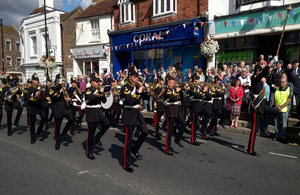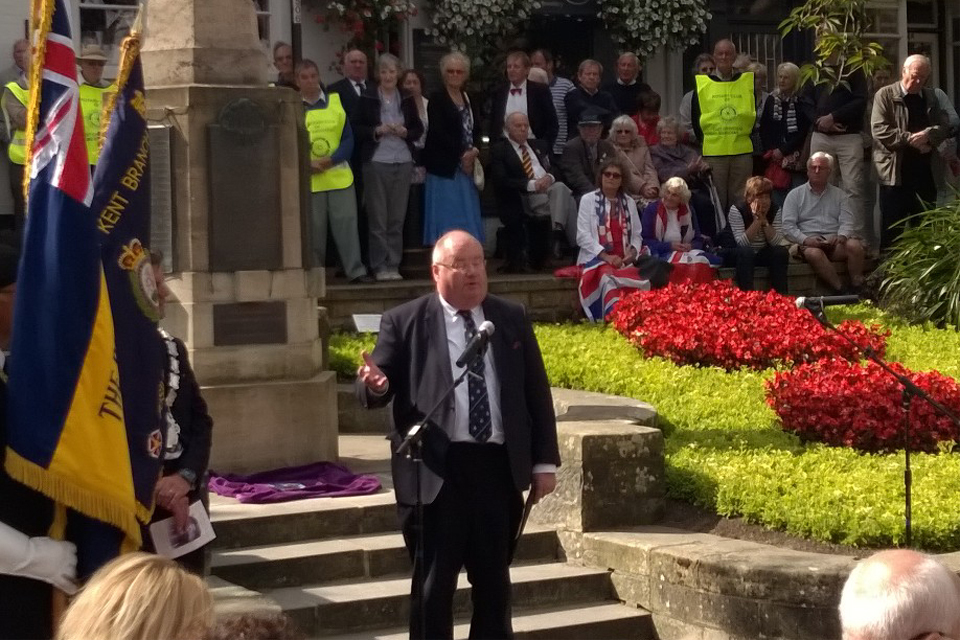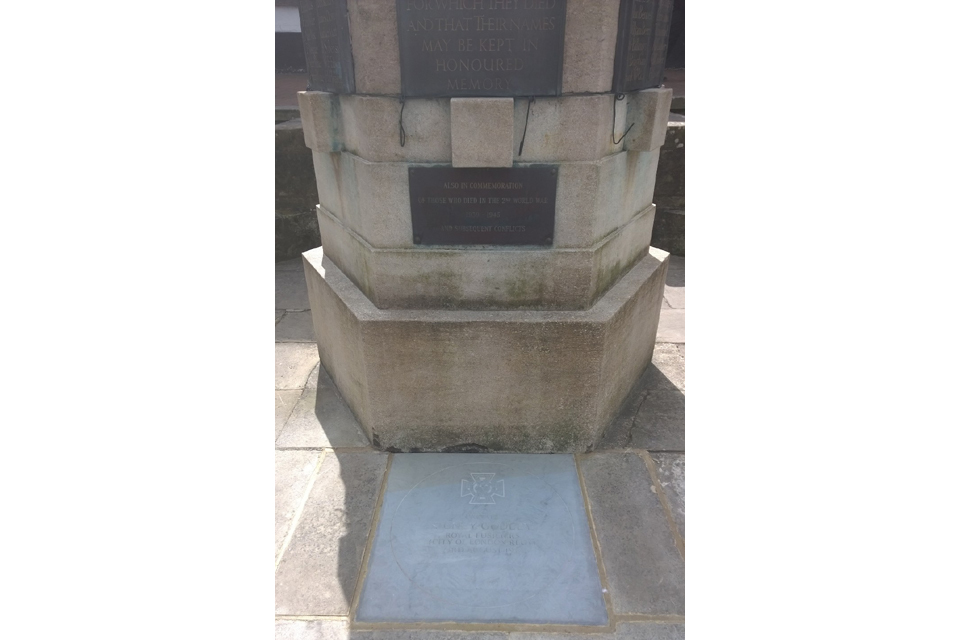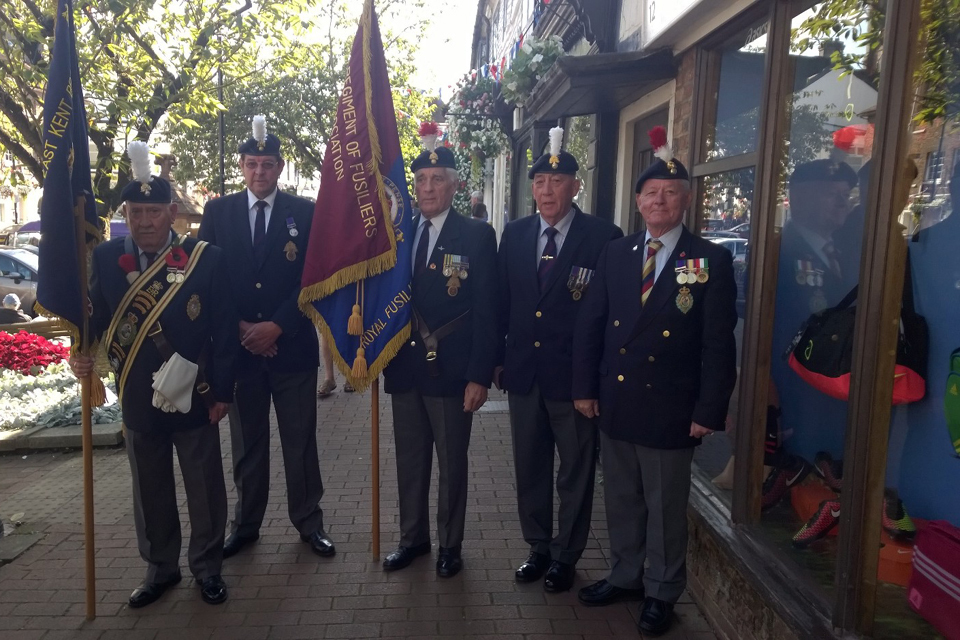Communities ministers attend first commemorative paving stones ceremonies
Communities Ministers are leading tributes to the bravery of World War One heroes.

Photo of the band of the Royal Logistics Corp marching in East Grinstead
Communities Ministers are this weekend (23 and 24 August 2014) leading tributes to the bravery of World War One heroes at the first ceremonies to mark the laying of commemorative Victoria Cross paving stones.
The stones will provide a lasting legacy to their gallantry in towns and cities across the United Kingdom and will enable residents to gain a greater understanding of how their area fitted into the history of the First World War.
In August 2013, Communities Secretary Eric Pickles announced a nationwide campaign to honour those who received the Victoria Cross (VC), Britain’s highest military honour, during the First World War. As part of this, over the next 4 years on the date corresponding to when they were awarded the VC, commemorative paving stones will be laid in their place of birth or where they lived following the war.
469 stones will be laid in communities in England, Wales, Scotland and Northern Ireland. The programme will also see 35 VC recipients commemorated in the Republic of Ireland. 145 stones will be laid in the National Memorial Arboretum to commemorate those born overseas.
The first stones will be laid on 23 August because the first Victoria Crosses were awarded on this date exactly 100 years ago. The last stones will be laid in November 2018.
On Saturday ceremonies will be taking place to honour:
- Private Sidney Godley VC - East Grinstead, West Sussex
- Corporal Charles Garforth VC - Brent, London
- Lieutenant Maurice Dease VC - Dublin, Ireland
- Corporal Charles Jarvis VC - Fraserburgh, Aberdeenshire
On Sunday ceremonies will be taking place to honour:
- Major Ernest Alexander VC - Liverpool
- Captain Francis Grenfell VC - Guildford, Surrey
Speaking ahead of his attendance at the laying of the paving stone to honour Private Sidney Godley VC, Eric Pickles said:
One hundred years ago today these brave young soldiers were rightly awarded Britain’s highest military honour for acts of exceptional courage in the cause of liberty.
Today communities are gathering to lay the first paving stones in their honour as a fitting tribute to their bravery. We remember that these men were not born heroes. They came from towns and cities just like ours, but went on to carry out astonishing acts of valour in service of their country.
Secretary of State speaking at launch in East Grinstead.

Secretary of State speaking at launch in East Grinstead
Memorial to Private Sidney Godley VC in East Grinstead high street alongside the paving stone.

Memorial to Private Sidney Godley VC in East Grinstead high street alongside the paving stone
Commemorative stone to Private Sidney Godley VC.

Commemorative stone to Private Sidney Godley VC
Royal fusiliers getting ready to honour Sidney - and the headlining photo shows the band of the Royal Logistics Corp marching in East Grinstead.

Royal fusiliers getting ready to honour Sidney
Communities Minister Penny Mordaunt speaking ahead of her attendance at the ceremony to honour Corporal Charles Garforth VC in Brent, London said:
This weekend we remember the first soldiers to be awarded the Victoria Cross in the First World War for their acts of valour or self-sacrifice. And over the weeks and months to follow from Allerdale to Wolverhampton great local events will be taking place to honour and celebrate local heroes.
I hope that these ceremonies will not only bring communities together, but will encourage people to find out more about the men who fought and died for this country and those men and women who contributed so much to the effort on the home front.
Sergeant Johnson Beharry VC with Penny Mordaunt at ceremony at Brent.

Sergeant Johnson Beharry VC with Penny Mordaunt at ceremony at Brent
Communities Minister, Lord Ahmad of Wimbledon speaking ahead of his visit to Dublin where he will join Heather Humphreys, Minister for Arts, Heritage and the Gaeltacht to honour Maurice Dease VC said:
It is a tremendous honour to be able to pay tribute to the courage of Maurice Dease, the first recipient of the first Victoria Cross in the First World War.
As his moving citation reads, his selfless acts of bravery at the Battle of Mons called for ‘no ordinary courage’.
Today in Dublin we commemorate this supreme act of valour. Over the next 4 years we will pause and remember the sacrifice that was made throughout Ireland and the commemorative stones will ensure that there is a permanent memorial to all these bravemen.
Further information
See the dates of upcoming paving stone laying ceremonies on this website.
Follow the laying of the commemorative stones on Twitter #VCpavingstones, and on Pinterest.
The decision about the site of each stone has been taken by the relevant local authority. Guidelines to local authorities encouraged them to site the stones in a location that would have had resonance with the VC recipient, such as outside a house that they lived in or near their old school. Most importantly, the stones should be part of the community and sited in a position where they will be visible to members of the public.
2014 marks 100 years since the start of the First World War. See details of commemorative events to mark 100 years since Britain entered the First World War.
Captain Theodore Wright VC (15 May 1883 – 14 September 1914) was also awarded the Victoria Cross on the 23 August 1914. A paving stone will be laid in his honour on 3 September in Brighton.
A public competition was held to choose a design for the paving stones and this was judged by a panel of 7 experts. The competition was won by Charlie MacKeith from London whose winning design will feature on all the paving stones that will be laid in communities across the country. The circular design seeks to ‘make one pause and remember’ and uses the material, form and lettering of the family of memorials used by the War Graves Commission.
The paving stones are made of Scoutmoor Yorkstone a hard-wearing British stone that is quarried near Ramsbottom. Each stone will include the name of the individual, the rank and regiment of the individual (at the time the VC was awarded) and the date of the action for which the VC was awarded.
All Victoria Cross recipients that were born overseas will be commemorated with a paving stone in the National Memorial Arboretum in Staffordshire. The Foreign and Commonwealth Office will also place commemorative plaques in countries around the world for men from overseas who received the Victoria Cross, for service in the First World War.
Biographies
Maurice James Dease VC (28 September 1889 – 23 August 1914)
Maurice Dease was one of the first British officer casualties of the war and the first posthumous recipient of the Victoria Cross. Born in Ireland, he attended the Royal Military College, Sandhurst, and became a lieutenant in the 4th Battalion, The Royal Fusiliers.
He died defending the Nimy Railway Bridge with Sidney Godley while the rest of the section retreated, on 23 August 1914, at Mons, Belgium, the first day of the first significant British encounter of the war. Maurice Dease was the first recipient of the first Victoria Cross in the First World War.
Sidney Frank Godley VC (14 August 1889 – 29 June 1957)
Sidney Godley was 25 years old, and a private in the 4th Battalion, The Royal Fusiliers. The citation for his VC reads: For coolness and gallantry in fighting his machine gun under a hot fire for 2 hours after he had been wounded at Mons on 23 August 1914, at Mons, Belgium. He was caught and was a prisoner of war until the Armistice. He received his VC medal from King George V in 1919. After the war he worked as a school caretaker in Tower Hamlets, London.
Charles Alfred Jarvis VC (29 March 1881 – 19 November 1948)
Charles Jarvis was a 33 year old Scotsman, and a lance-corporal in the 57th Field Company, Royal Engineers. Only 3 weeks into the war on 23 August 1914 at Jemappes, Belgium, Lance-Corporal Jarvis worked for 1½ hours under heavy fire, in full view of the enemy and finally succeeded in firing charges for the demolition of a bridge. He was wounded in the process.
He was presented with his medal in 1915. He was later promoted to second corporal and corporal before being discharged from the Army in 1917. He went on to work at the Naval Dockyard at Portsmouth.
Charles Garforth VC (23 October 1891 – 1 July 1973)
Charles Garforth was 22 years old, and a corporal in the 15th (The King’s) Hussars. He was born in Willesden Green, London.
On 23 August 1914 at Harmingnies, France, Corporal Garforth volunteered to cut wire under fire, which enabled his squadron to escape. On 2 September when under constant fire, he extricated a sergeant who was lying under his dead horse, and carried him to safety. The next day, when another sergeant had lost his horse in a similar way, Corporal Garforth drew off the enemy fire and enabled the sergeant to get away.
He was taken prisoner in October 1914 and was repatriated in November 1918. He later achieved the rank of sergeant. Charles Garforth died on 1 July 1973 at Beeston, Nottingham, and was cremated at the Wilford Hill Cemetery Crematorium. His ashes were scattered in the Garden of Remembrance.
Major General Ernest Wright Alexander VC CB CMG (2 October 1870 – 25 August 1934)
Ernest Alexander was trained at the Royal Military College, Sandhurst and commissioned into the British Army. At the age of 43, as a major in the 119th Battery Royal Field Artillery, during the First World War, he was awarded the Victoria Cross for gallantry.
On 24 August 1914, during the action of Elouges, Belgium, when the flank guard was attacked by a German corps, Alexander handled his battery against overwhelming odds with such conspicuous success that all his guns were saved notwithstanding that they had to be withdrawn by hand by himself and volunteers led by a Captain (Francis Octavus Grenfell) of the 9th Lancers. This enabled the retirement of the 5th Division to be carried out without serious loss. Subsequently, Major Alexander rescued a wounded man under heavy fire.
Francis Octavius Grenfell, VC (4 September 1880 – 24 May 1915)
Francis Grenfell was 33 years old, and a Captain in the 9th (Queen’s Royal) Lancers, British Army during the First World War when the following deed during the Action of Elouges took place for which he was awarded the VC.
On 24 August 1914 at Audregnies, Belgium, Captain Grenfell rode with the regiment in a charge against a large body of unbroken German infantry. The casualties were very heavy and the captain was left as the senior officer. He was rallying part of the regiment behind a railway embankment when he was twice hit and severely wounded. In spite of his injuries, however, when asked for help in saving the guns, by Major Ernest Wright Alexander of the 119th Battery, Royal Field Artillery, he and some volunteers, under a hail of bullets, helped to manhandle and push the guns out of range of enemy fire. The citation was gazetted on 16 September 1914 and read:
For gallantry in action against unbroken infantry at Andregnies, Belgium, on 24th August 1914, and for gallant conduct in assisting to save the guns of the 119th Battery, Royal Field Artillery, near Doubon the same day.
He was killed in action on 24 May 1915 and is buried in the Vlamertinghe Military Cemetery, Belgium.
Office address and general enquiries
2 Marsham StreetLondon
SW1P 4DF
Contact form https://www.gov.uk/gui...
General enquiries: please use this number if you are a member of the public 030 3444 0000
If your enquiry is related to COVID-19 please check our guidance page first before you contact us - https://www.gov.uk/guidance/coronavirus-covid-19-guidance-for-local-government.
If you still need to contact us please use the contact form above to get in touch, because of coronavirus (COVID-19). If you send it by post it will not receive a reply within normal timescale.
Media enquiries
Email newsdesk@communities.gov.uk
Please use this number if you are a journalist wishing to speak to Press Office 0303 444 1209